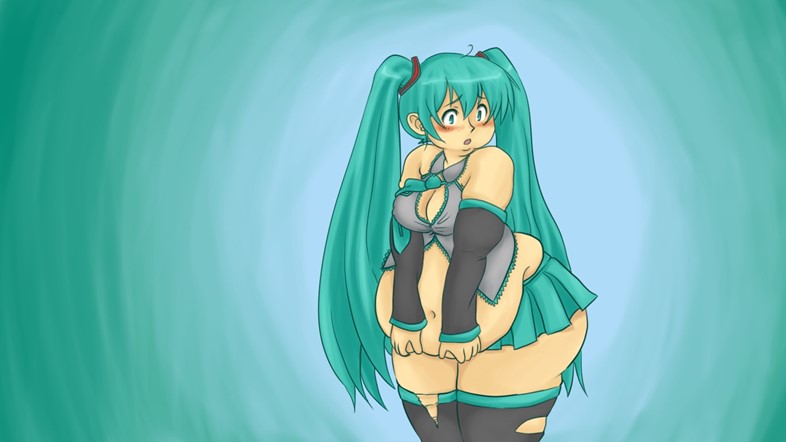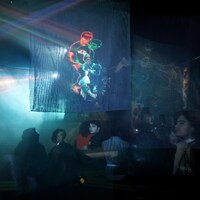Looking back on the career of the blue-haired, forever teenaged singer who opened for Lady Gaga, has over 100,000 songs and was dressed by Marc Jacobs
Hatsune Miku has done a lot for a 16-year-old. She’s sold-out shows across the world, collaborated with Pharrell, and opened for Lady Gaga on her ARTPOP tour. She has over 100,000 songs in her discography and a globe-spanning number one album. She’s done a spread in Japanese Playboy and gone to space twice. By all measurements, she’s one of the most important and accomplished figures in popular music. The only thing is, she’s not real – at least, not ‘real’ as we know it.
Major pop stars are, arguably, constructs: some moulded in a lab staffed by label bosses and publicists, parts taken from trend sheets and focus groups to be cut for the consumer market. None, though, are created in the same sense that Hatsune Miku is. She’s a virtual pop princess first birthed by Japanese software developers, who launched a program that allowed users to take Miku – an eternal 16-year-old, with knee-length candy blue pigtails and big anime eyes – and create songs with her as they wished. Since 2007, users of the Crypton Future Media package have added music videos, hundreds of thousands of songs, and fan art to the iconography of the cyber pop star.
Now, Hatsune Miku: Still Be Here will see the virtual musician take to London’s Barbican stage in collaboration with artist Mari Matsutoya, electronic musician and producer Laurel Halo, choreographer Darren Johnston, visual artist Matin Sulzer, and virtual artist LaTurbo Avedon. Straddling IRL and URL, Miku inhabits the hyperreal planes we’re just out of reach of, and her setlist questions identity in a technology-focused society, the role of celebrity and the commodification of female bodies. Here’s everything you need to know about Hatsune Miku.
THE BIRTH OF HATSUNE MIKU
Back in 2000, Yamaha began developing Vocaloid, a program for vocal synthesizers that would mimic the sounds and intonations of a real human voice. It was initially meant for electronic musicians who weren’t able to access vocalists. As Crypton CEO Hiroyuki Ito told Geekscape in 2014, “an amateur songwriter, for example, could insert a synthetic voice in his home studio to create a demo recording of a song. But since there’s such a rich anime culture in Japan, we thought maybe by adding some kind of animated character, we could figure out a whole new way of utilizing Vocaloid technology.”
Miku is not the only voice synthesizer with a character, nor is she the first: there’s Megurine Luka, Kagamine Ren, Len, and Kaito, but Miku definitely has the biggest reach. First came the brown-haired, red-leather-suited Meiko in 2004, and Kaito was the next level-up in 2006 as the moody artist type in a white trenchcoat. 2007 welcomed Hatsune Miku, which translates as “first sound of the future”. Crypton Future Media built upon the anime aesthetic that enticed their fan base, with Miku voiced by anime actress Saki Fujita.

THE EXPONENTIAL RISE OF UNIQUE CYBERPOP
Given no background or story, Hatsune Miku was a blank canvas, presented in the software pack for users to creatively manipulate. Within days of launching in 2007, her developers saw fanpages, tribute art and burgeoning Cosplay communities, people far removed from the electronic musicians they originally targeted. Instead of launching their own manga series or clamping down with capitalising licences, a social media network called Piapro.jp was founded for the Vocaloid fans to upload the songs they created for the humanoid. Japanese video sharing site Nico Nico Douga also grew as the first network for hosting the music.
The scope that Hatsune Miku covers was also helped along by the licensing agreement set up by Crypton called MikuP. Users could create and publish tracks using the software without having to pay royalties for their original pieces of work. The creative freedom means people aren’t just fans of Hatsune Miku, but her close collaborators. Piapro.jp was filled with threads where producers engaged with each other on Miku projects over the internet, and the globe-spanning community saw Miku launched into the pop stratosphere. Sega localised much of Miku’s lyrics into English in 2014 for the rhythm game Hatsune Miku: Project Diva F 2nd, giving fans outside of Japan a chance to empathise with her lyrically, sledge-hammering at the Western mainstream.
MIKU’S DISCOGRAPHY AND HER LYRICAL PROWESS
The avi-singer software has been likened to Garageband, and her entire discography spans over 100,000 songs all created by fans. There’s plenty of DIY music videos out there too, touching upon a variety of genres – EDM, bubblegum pop and even an opera performance, where her outfit was designed by Marc Jacobs for Louis Vuitton. Miku has additionally ‘collaborated’ with other Vocaloid beings: “As The Gods Say” or “Kami No Manimani” featuring Kagamine Rin and GUMI, and “Hikyou Sentai Urotandar”/”Cowards Fighters” featuring Kaito and Meiko.
Kz is one of the biggest producers credited with Miku’s works, with much of their lyrics based on the Hatsune Miku fandom. One of Kz’s creations was remixed by Pharrell for Takashi Murakami’s film, Jellyfish Eyes, and the music video, directed by Murakami, saw Miku board a spaceship with a cartoon Pharrell. Kz’s track “Tell Your World” was licenced by Google for a Chrome advertisement.
Much of her lyrics explore the hopes and dreams of an ambitious teenager, in line with the aesthetic Hatsune Miku first entered the world with. As a non-human entity, producers have imposed a range of emotions and personal stories that they maybe couldn’t express themselves. Hatsune Miku has the tools to represent the loves, trials and tribulations of the world. Halo’s Barbican performance songs will explore Miku as a tech entity, and what that means for our own sense of identity. In “Irony”, she laments the passage of time and how lost she feels, in translated lyrics via Artifice: “I want to take a little break, but time cruelly goes, hour by hour, and so, drags me right along”. Then, there’s “Popipo” a playful song about tomato juice. The ‘Hatsune Miku Amend’ add-on released by Crypton advanced Miku’s tone of voice to better channel emotions, with ‘vivid’, ‘mature’, ‘solid’ and ‘light’ options.
Other producers, like Satsuki Ga Tenkomori, have chosen to subvert the cutesy, innocent pop in favour of a darker image. “Party Junkie” illustrates a drug-addled it-girl, and Machigerita P’s “Rotten Girl, Grotesque Romance” plays on the Japanese female archetype of a yandere (a lovestruck, seemingly innocent girl who gets violent when jilted). According to Artifice, Machigerita P’s lyrical tale of Miku’s violent stalking did the rounds as a freaky Creepypasta that many believed to be based on real life.
PLAYBOY, SPACE AND LETTERMAN: MIKU’S ICONOGRAPHY
Miku has the ability, unlike artists outside her hyperreal world, to be many places at once. Like other musicians (think Snoop Dogg repping for anti-malware software Norton Anti-Virus or Mary J. Blige for Burger King and it’s not that weird), she has her share of endorsements. After all, a hologram’s gotta pay her bills. She was the official sponsor for Toyota Corolla in 2011, appearing in two TV advertisements. Miku has also been launched into space twice as a chibi doll, and – quite bizarrely, given that she’s meant to be 16 – graced the pages of Japanese Playboy for a ‘5D’ shoot with pin-up model Risa Yoshiki.
Miku has also been launched into space twice as a chibi doll, and – quite bizarrely, given that she’s meant to be 16 – graced the pages of Japanese Playboy for a ‘5D’ shoot with pin-up model Risa Yoshiki. Featured in Sega’s game Project Diva, there’s also a faithful legion of blue pigtailed Cosplayers and a huge annual Miku Miku Dance Cup, where users compete to make the best original Miku video – it’s basically an entire YouTube subculture of its own. On the streets of Akihabara, you can get blue Yakisoba noodles modeled after her hair. And not all these ventures, like with any real life celebrities, have turned out well – a motorcycle racer died while riding a Miku-adorned vehicle, and a Miku snow sculpture almost killed a woman at the Sapporo Snow Festival.
Taking the world stage, the Miku hologram opened Lady Gaga’s artRave: The ARTPOP Ball Tour in 2014, singing one of her popular tracks “Share the World”. Performing on the David Letterman show (to a perplexed host) was probably her biggest audience yet, and a real crack at the western music sphere. Because of the creative commons licence, many Hatsune Miku shows worldwide aren’t official, but that doesn’t stop the thousands of fans – the wildest in Japan – from coming out for the star.
IDENTITY AS AN AVATAR
While she can’t Good Girl Gone Bad her entire image, club-hop in Soho or release a tell-all evangelical Christian reckoning memoir, the open source aspect of the software means, of course, Hatsune Miku is open for interpretation by everyone. She’s slim, beautiful and underage – physicality is the only thing imposed by Crypton Future Media. The sexualisation of a teenage avatar happens because the internet is the creepy internet. There’s a huge output of Miku-inspired porn online and in comic form, actual sex toys and a catalogue of songs that reference her short skirt and sweet image.
How much can we fully give into the Miku experience though, when we know she’s an unreal, arguably unfeeling being? “People focus on the live show like it’s so bizarre,” Ian Condry, a professor of Japanese studies at MIT, told Huffington Post. Condry explains that the crowd invest in her, as well as everything she represents: “They know Miku doesn’t exist, but they know people on the other side do.” Miku is the voice of thousands on the internet: people with musical ability and no major output, people creatively feeling their way.
A virtual female puppet, however, is questionable in itself: the attractive avatar as a mouthpiece for everyone else’s stories and emotions except her own, because she doesn’t have the one personality or individual narrative.
While people have certainly taken liberties with this Vocaloid, the 2012 collab with Marc Jacobs for Louis Vuitton, which saw Jacobs design her outfit for an opera show, was met with major fan backlash. Elsewhere, Miku has propped up a lesbian fanbase – there’s videos and tracks out there that tell the story of a same-sex relationship with other Vocaloids avatars. The track “Magnet” tells the story of forbidden love between Miku and Luka. There’s also a fan art trend ‘Fatsune Miku’, where people have turned their back on the thin Miku in favour for a larger woman.

THE FUTURE OF POST-HUMAN POP
Fans of the virtual artist have found a star in Miku, as well as a faithful collaborator that elevates fandoms like no other star could – forget the Beyhive or Rihanna Navy. Because of Instagram and Q+A live streams, we’ve grown intensely close to our idols, this may just be the next step. Many Miku producers have gone onto careers – like the aforementioned Kz, now composing for real-life J-Pop artists, and the groups Supercell and Livetune all made a start writing for her.
So could Hatsune Miku be the future of pop? Many mainstream artists are more or less constructed in laboratory-like record label offices; many fight to leave contracts that afford them no individual creative freedom. As a plus for industry bosses, Miku won’t insult her fandom in a drunk and swiftly deleted Twitter rant, or voice unpopular political opinions and end up splashed across the tabloids. And as Vulture asserts, she could be opening the door for the next step for music: post-human pop, going beyond holograms at Coachella, the Gorillaz and the anonymous helmets of Daft Punk. Whatever the case and in whatever form, Hatsune Miku is a permanent megastar in the pop culture constellation.
Hatsune Miku: Still Be Here will show at the Barbican February 26




